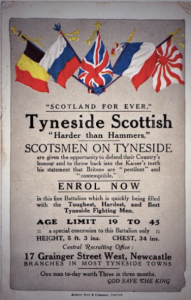First published by Bella Caledonia, 11 July 2014
 It’s a truism that, down the centuries, Scotland’s greatest export has been its people. Indeed, a strong element of the current Year of Homecoming—allied with the hosting of the 20th Commonwealth Games in Glasgow—is attracting visitors from the wider Scottish Diaspora, which is estimated to be between 28 and 40 million people around the world.
It’s a truism that, down the centuries, Scotland’s greatest export has been its people. Indeed, a strong element of the current Year of Homecoming—allied with the hosting of the 20th Commonwealth Games in Glasgow—is attracting visitors from the wider Scottish Diaspora, which is estimated to be between 28 and 40 million people around the world.
2014 is also, of course, the centenary of the outbreak of the First World War; yet, as a new exhibition opening today at the National Museum of Scotland suggests, the military aspects of the Scottish Diaspora across the Commonwealth (and, in particular, Australia, New Zealand, Canada, South Africa and–not forgetting–England) have often been overlooked.
“The relationship between emigration and military service is part of the story of the Scottish Diaspora which academics and museums have only recently begun to look at again,” explained Dr Stuart Allan, Principle Curator of Scottish Late Modern collections at National Museums Scotland. “Common Cause is a timely reflection on the relationship between Scottish identity, the experience of war and the emerging national identities of Commonwealth countries where Scots settled in large numbers, countries which made such a significant contribution to the war effort.”
The reproduction of a 1918 official Government poster is a case in point: what you immediately notice about “the British Commonwealth in Arms” is that both Canada and South Africa are represented by soldiers in kilts. Certainly, the exhibit shows that even non-Scottish (though, it has to be said, all white) recruits and units from South Africa appeared to have shared a sense of Scottish military identity. Admittedly, on occasions it was adapted to local conditions; the regimental mascot of “the South African Scottish” was a Springbok called ‘Nancy’, which is one of the five principle exhibits forming the core of the exhibition.
Staunch unionists may well enjoy the exhibition’s apparent confirmation of people having multiple national identities; one of the core exhibits, after all, is the Victoria Cross presented to Ulster Scot James Crichton who fought for the New Zealand Expeditionary Force. Yet they may equally blanche at the sight of a Highland broadsword inscribed “LNB” on the blade, identifying it as one carried by a member of the “Loyal North Britons”, the second Scottish volunteer unit originally instigated by the Highland Society of London in 1803.
Yet what comes across most clearly throughout the exhibition is not just the resilience of a specifically Scottish military identity (even in England, with Scottish regiments formed in London, Manchester and Liverpool), but also the role of that “Scottishness” in helping forge the new national identities of those nascent Commonwealth nations. Admittedly, some were further down the road than others; as that same war poster shows, Australia and New Zealand were already their own men.
The exhibition is grouped primarily around five ‘national’ display cases, each hooked on one specific object loaned by the respective country: in addition to those already mentioned, there are a set of bagpipes retrieved from the fields of the Somme (Canada), the sculpture of an archetypal Australian soldier by William Wallace Anderson, and the field communion set of Reverend DC Lusk (a presbyterian chaplain who served with the 1st Battalion London Scottish).
In some respects the items on display are precisely what you’d expect to see in any military-themed exhibition—swords, medals, and the hauntingly silent newsreel footage of the mud-churned battlefields. Nevertheless, there are the occasional, truly personal touches which genuinely touch the heart: the Christmas card sent back to Australia from the European front; the purse containing coins damaged by the bullet which injured a soldier called Harold Brierley; the “thank you” cards sent out by the parents who had lost their 24 year old son on the battlefield. Questions of national identity aside, those symbolise the shared human injury and loss that the First World War represented to millions of people around the world.
Common Cause: Commonwealth Scots and the Great War runs at the National Museum of Scotland, Chambers Street, from 11 July to 12 October. Admission free.
The exhibition is part of the programmes of the First World War Centenary Partnership, http://www.1914.org, and Homecoming Scotland, http://www.homecomingscotland.com. It is one of five projects which have received funding from the Scottish Government to engage with Scotland’s Diaspora during 2014.